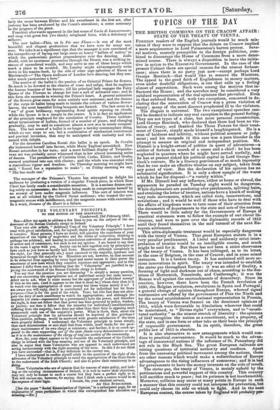THE THEATRES.
The extra night, or "long Thursday," at the Operahouse, was reduced this week to moderate dimensions, the performances being over before midnight. Gardoni appeared in a new part—Eltrino in La Sonnavibula; and made even a greater impression than in La Favorita. His assumption of the character was complete: in every look, movement, and gesture, he was the handsome country lad, unpolished in manners, passionately in love, and a rural Othello in jealousy. He softened down, with great felicity, some of the harshnesses of the character; especially in the scene where El- vino forces the ring from the poor girl's finger—which is generally rendered offensively brutal, but which he tempered by his strong expression of an- guish. His singing was like his acting—not remarkable for striking points, but full of beauty, simplicity, and dramatic truth. As a whole, we prefer Gardoni's Elvino to any that we have seen. Madame Castellan's sweet and touching representation of the village heroine is well known; and never was it more effective than on this occasion. In the last scene, the dreaming girl's unconscious effusion of grief and tenderness was inexpres- sibly mournful; and her burst of happiness when she woke—" 0 ;OW" —had a visibly electric effect on the audience. F.,Lablache acted Conn4 Rodolfo in his wonted manly and gentlemanlike manner. Madame Solari was very respectable in Lisa. Considerable dramatic effect was given to the choruses; and the whole opera was more than usually pleasing and inte- resting. We regretted, however, the omission of some passages, partacu- lark), the scene between Elvino and his sweetheart in the first act, after jealousy has been awakened by the Count's attentions; a scene necessary to the progress of the piece. Fraschiui afterwards appeared in the last scene of Lucia di Lammermoor; and sang with great but (we think) misplaced force, with a deficiency of softness.
The new ballet—Tlaia, ou in Fee our Fleurs — is one of the most beautiful and elegant productions that we have seen for many sea- sons. We take it as a significant sign that the manager is now convinced of the inexpediency of laying out large sums on heavy " ballets of action," in which the pantomimic portion preponderates over the dancing. Lally Rookh, with its enormous procession through the Desert, was a striking in- stance of squandered wealth, and may serve as one of those buoys which mark a place to be avoided. Mr. Lumley might advantageously write down in his maxim-book, by the side of some sage aphorism of Bacon or Machiavelli—" The Opera audience of London love dancing, but they con- sider much pantomime a bore."
The motive of the ballet is the passion of an Oriental Prince for flowers. So much is he devoted to the charms of roses and tulips, that he neglects the human beauties of his harem; till his principal lady engages the Fairy Queen of the Flowers to change her into a sort of animated rose; and in this form she succeeds in winning the Prince's heart. A general animation of the flowers gives room for some entirely new costumes; and the dresses of the corps de ballet being made to imitate the colours of various flower- leaves, the most beautiful living bouquets are formed. The last scene is a " set " of great brilliancy, representing floral spirits reposing on clouds, while the Queen is in a temple in the centre. It is in fact an application of the principle employed for the conclusion of Coralia. These emblem- atical terminations of ballets, formed of a number of pieces, and changing gradually, may be said to constitute almost a new sera in scenic composi- tion. The last scene of a ballet is no longer a tawdry commonplace thing, which no one stops to see, but a combination of mechanical contrivance and poetical invention, that may be anticipated with curiosity and wit- nessed with delight.
For the danseuse Carolina Rosati this ballet is an epoch. In Coralia she insinuated herself into favour, while Marie Taglioni astonished. Now Rosati astonishes in her turn; and a more brilliant display of Terpsicho- rean art was probably never witnessed than in her almost unceasing series of dances. The peculiarities of Carlotta Grisi, Cerito, Ellsler, and Grahn, seemed combined into one rich cluster; and the whole was executed with a marvellous vigour and freedom. On Thursday morning we might have said, " Rosati has a reputation to make "; on Friday morning we say, " She has made one."



























 Previous page
Previous page